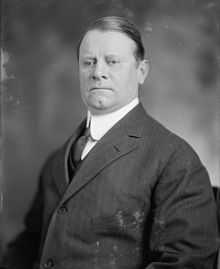George W. Loft
George William Loft (born February 6, 1865 in New York City , † November 6, 1943 in Baldwin , New York ) was an American politician . Between 1913 and 1917 he represented New York State in the US House of Representatives .
Career
George Loft was born and raised in New York about four months before the end of the Civil War . During this time he attended public schools. Since his early youth, he then went on to manufacture confectionery. He was a director of several corporations . His first wife, Elizabeth M., died on May 9, 1910. He then married his second wife, Julia McMahon, on June 17, 1911, whom he met as a saleswoman in his shop at 54 Barclay Street in New York City. The couple moved to Baldwin, Long Island . On May 12, 1921, Julia was made an honorary Deputy Police Commissioner in New York City. She then announced that she would be active in her position and perform her duties on a full-time basis.
Politically, he belonged to the Democratic Party . He was elected to the US House of Representatives in Washington, DC in a by-election on November 4, 1913 in the 13th constituency of New York to fill the vacancy created by the death of Timothy Sullivan . In the 1914 congressional elections for the 64th Congress , he was elected to the US House of Representatives. Since he on a run again in 1916 renounced, he left the after March 3, 1917 Congress of.
After his time at the Congress, he went back to the manufacture of confectionery. In 1927 he founded the Emerald National Bank & Trust Co. in its own building on Seventh Avenue and 33rd Street in Manhattan . Two years later he founded the South Shore Trust Co. in Rockville Center , Nassau County , where he served as president until his death. At that time he also stopped making confectionery. He took part as a delegate to the Democratic National Conventions in 1924, 1928, 1932, 1936 and 1940 . He died in Baldwin on November 6, 1943 and was buried in St. Raymond's Cemetery in Westchester . About two years later the Second World War ended .
Trivia
From around 1915 he became involved in whole blood - horse racing . His stable in flat races was trained by the future Hall of Fame trainer, Max Hirsch (1880–1969). He had a number of qualitativhochwerigen racehorses, including the colt ( colt ) Papp and the filly ( filly ) July Chamaleon . In 1917, Papp won the most important race for two-year-olds, the Belmont Futurity Stakes , and Julialeon won the Stuyvesant Handicap at the Jamaica Racetrack . In 1920 he acquired Tippity Witchet , a gelding who ran races until he was 14 years old and, after being sold at the end of the same year, came out on top in 78 races. Loft won the prestigious Manhattan Handicap in 1925 with his gelding Pepp. In the steeplechase race of 1922, his horse Sweepment emerged as a champion timber topper .
Honors
The George W. Loft ferry was named in his honor in New York City in 1923.
Web links
- George W. Loft in the Biographical Directory of the United States Congress (English)
- George W. Loft in the database of Find a Grave (English)
Individual evidence
- ^ "Obituary," The New York Times, May 11, 1910
- ↑ "Mrs. George W. Loft New Police Deputy, ” The New York Times, May 13, 1921
- ^ "Business & Finance: Accidental Banker," Time Magazine, April 4, 1927
- ^ "GW Loft to head New Midtown Bank," The New York Times, 1927
- ↑ "Tippity Witchet is winner at Belmont" , The New York Times, 11 September 1920
- ^ "Loft's Pepp first as Belmont Opens," The New York Times, September 2, 1925
- ^ "Sweepment leads Timber Toppers," The New York Times, April 29, 1922
| personal data | |
|---|---|
| SURNAME | Loft, George W. |
| ALTERNATIVE NAMES | Loft, George William |
| BRIEF DESCRIPTION | American politician |
| DATE OF BIRTH | February 6, 1865 |
| PLACE OF BIRTH | New York City |
| DATE OF DEATH | November 6, 1943 |
| Place of death | Baldwin , New York |

